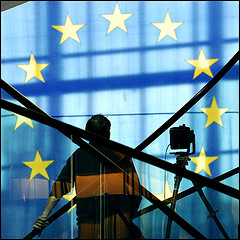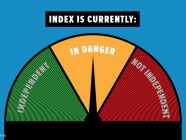 Of the 27 indicators of professional media standards defined by the Council of Europe, Serbia meets only four.
Of the 27 indicators of professional media standards defined by the Council of Europe, Serbia meets only four.
A report detailing the challenges of Serbian media, titled “Serbian Media Scene VS European Standards,” offers analysis related to the legal, political, economic, and professional environment surrounding the industry. While most of the remaining 23 standards are characterized by relatively solid legislative framework, their practical implementation is lacking in Serbia.
The analysis is the product of a joint effort undertaken by the Civil Rights Defenders organization, the Association of Independent Electronic Media (ANEM), the Independent Journalists’ Association of Serbia (NUNS), the Independent Journalists’ Association of Vojvodina (NDNV) and Local Press (Association of Local Independent Media). Included are interviews with 240 editors-in-chief of media outlets from 79 towns in Serbia; 69 media owners; 40 political party officials; 50 members of nine national minorities; and representatives of 26 governmental, regulatory, and self-regulatory bodies in the media sector.
Results of the research show that only two percent of the interviewed editors believe that freedom of the media and rights of journalists were fully exercised and achieved during the last year. At the same time, 72 percent of interviewed editors of news media outlets believe that existing public service broadcasters are not protected from political influence in their everyday activities, while 66 percent believe that the principle of no clear political affiliation in higher executive positions in the media is not upheld.
The president of NUNS, Vukasin Obradovic, points out the problems related to financing both public service broadcasters (Radio-Television Serbia and Radio-Television Vojvodina), which have suffered losses for years, making them increasingly susceptible to outside influence. Obradovic says the share of two main sources of RTS financing were not known due to a lack of transparency and the absence of recent documentation.
Research coordinator Jovanka Matic emphasized that publicly owned media in Serbia is financed by donations from the national budget, while the allocation of these funds is non-transparent and biased. The president of the Local Press association, Dejan Miladinovic, says a significant amount of money was paid from the national budget for advertising in the media, with roughly €40 million allocated for this purpose in 2011. This fact is especially alarming considering the average salary in 72 percent of the polled media outlets amounted to less than 30,000 dinars (roughly €260 euros).
The existence of pressure on the media is evidenced by 73 cases of drastic violations of media freedoms and rights registered in the last year – including nine physical attacks on journalists, 18 threats against physical integrity, and the firing of four editors-in-chief or media directors. At the same time, 242 charges against the media were initiated before courts in Belgrade: the largest number of lawsuits (47) were launched against the company Ringier, followed by daily newspapers Kurir (34 lawsuits), Press (27), Novosti (17) and Politika (14), while the most often-sued electronic media outlets were TV B92, TV Pink and RTS.
As a consequence of the deficiencies characterizing the domestic media market, only four European standards of media freedom have been fully achieved in Serbia – the freedom of entry into journalism, the freedom of access to the Internet and the foreign media, separation of participation in the executive branch from professional media positions, and limitation of the right of the media to exclusive reporting on events of exceptional public importance.
Full results of the research are available in the publication The Freedom of the Media in Serbia in the European Mirror.
Tags: 27 Media Freedom Indicators, Budget donations, Dejan Miladinovic, Jovanka Matic, Media advertising, Media Freedom, Political influence, Vukasin Obradovic














































